把脉老建筑文化 追溯白象街老故事
□文、图/本刊记者 杨艳
把脉老建筑文化 追溯白象街老故事
□文、图/本刊记者 杨艳
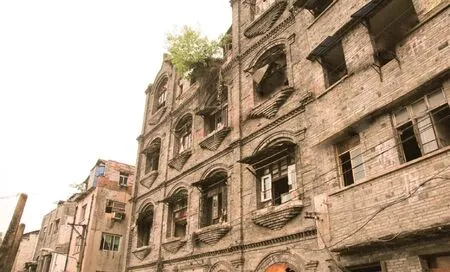
青灰砖墙承载着白象街多少历史旧事。(图片由重庆文物保护志愿者服务队提供)
以历史为根 话当年老街
白象街曾是1891年重庆开埠后的经济中心,这块巴掌大的地方拥有重庆最早的有线电报局、药材公会、大清邮局、美国大来公司,吸引过全中国乃至全世界的目光,曾被外界称之为“金融街”,英、美、日等国家在这一带开设洋行捞金,正如纽约华尔街,各界名流络绎不绝。
阳春三月,在万物苏醒的季节,记者以一个探寻者的姿态走在焕然一新的白象街。这里依旧是青灰格调砖墙、欧式门窗、木质房檐,还有质朴的民国建筑风格,但感受到的是一种古老而绵长的氤氲气息,仿佛时空交错,怀旧的情绪就此弥散开来。
白象街贯穿于望龙门与太平门之间。它的名字来源于一个传说,相传很久以前,在这条街上就有一尊汉白玉雕塑的石象,我们现在在白象街头就能看到一尊新石象,恰好和南岸玄坛庙一对青石狮相对,民间说这是“青狮白象锁大江”。
近年来,重庆市政府不断加大母城历史文物的挖掘、保护、利用和传承工作,开发、建设历史文化街区,以此传承历史文脉,弘扬巴渝文化。作为下半城历史文化街区的修复项目的一部分,现在的白象街开启了城市建设的新篇章。它被赋予了新时代的城市功能和新特色,依托重庆的开埠文化,在“保护中开发,开发中保护”的理念下,以“保护、织补、针灸、缝合”的规划手段,多处文物建筑保持原有的面貌。一座集文化、历史、旅游、商业为一体的综合区域正在原地“复活”,这些建筑不仅是承载重庆人记忆的容器,还组合出一幅新画卷,成为重庆会客世界的城市名片和“新客厅”,这里就曾接待过法国总统弗朗索瓦·奥朗德、美国总统家族成员尼尔·布什等全球名人政要。
目前,还有部分老建筑正在紧张的修复中,当这些老建筑再次回到大家的视野之中,当“旧”与“新”相遇,将抒写出别样的精致和优雅。新的白象街将唤起重庆人对老城的记忆,加深新一代年轻人对这座城市的解读。那些散落在白象街的每一个历史遗迹和每一栋老建筑,都拥有值得回味的过去。今天,就跟随记者的脚步,一起去探寻它们背后的故事。
药材公会旧址:见证一段重庆药材行业辉煌史
记者很容易就在街巷内找到药材公会旧址,整栋建筑经过原地复建,气派依旧。3层高的洋房前依然是那棵苦楝树,枝繁叶茂,据说这棵树是当年药材同业公会的首任会长在公会成立时亲手种下的。小院中心新修了一个大型的喷泉,建筑顶部有3个近5米高的拱型门洞,典型的巴洛克风格。曾经掌握着重庆药材销售命脉的药材公会,现在已成为了一个文化艺术的聚集地,吸引了不少文化人、艺术家。3月5日,法国索菲亚艺术基金会就在此举办了一场当代女艺术家绘画展,50多幅绘画作品齐聚于此,当老建筑遇上艺术,它以崭新的面貌,向世人彰显着高雅与华贵。
追溯其历史,明末清初时期,药材帮在重庆有着举足轻重的地位。盛行水运,渝中区占据了长江、嘉陵江两大黄金水道的优势,外省的江西临安帮成为第一个在白象街设立药材商号的帮会,随即浙江帮、广东帮等也相继涌入,于是白象街这一带成为了鄂、湘、赣、粤连接西南各省的咽喉中转站,一时间变身为全国当时最繁忙的药材市场。
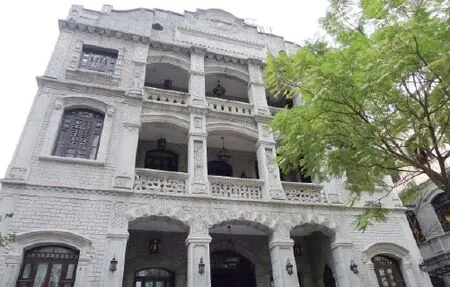
据重庆海关税务司记载,若将1930年至1939年间的重庆出口总量做一个排名,山货、桐油、药材,分别排名前三。当年药材市场一带,商家商铺林立,由于商铺越来越多,行业竞争越来越激烈,重庆本地的“药七帮”与外省“十三帮”之间的矛盾也愈演愈烈。为了实现共赢,1926年6月,经过各药材帮会多次协商,成立了重庆药材同业公会,药材市场这才从恶意竞争走向了共同合作,从此,就有了白象街这栋洋楼,也就是药材公会旧址。曾几何时,往来于此的必定是中国医药行业中颇有影响力的人物,许多牵动药材市场的重要决定都在此开会协商而定。
时光荏苒,岁月悠悠,曾经喧闹的码头归于沉寂。直到现在,药材市场附近依旧有许多药材店铺,每次经过,我们都能闻到浓烈的药材味,而这药材公会旧址在现代的气息中“醒”来,百年建筑的绵长风韵与现代艺术文化在此相碰撞,协奏出穿透时光的交响曲。
李耀庭公馆:重庆的第一盏电灯就在此点亮
往靠江一侧大片的建筑工地远远望去,数栋建筑物外层被高高的脚手架以及绿色的围网包裹着,周围是连排而建的工棚,工人正在工地上忙碌。在一块平地之中,一栋小楼格外显眼,打量其轮廓,记者第一时间认出它就是卜凤居,西南首富李耀庭的公馆。
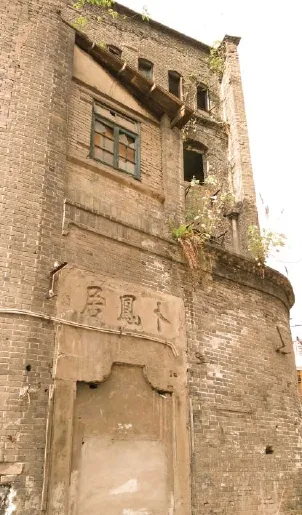
透过绿色的围网,还能清楚地看到镶嵌在青石墙上的木窗棂,底层有一扇青石门,上面写着“卜凤居”。据史料《渝中金融史话》记载,李耀庭出身贫寒,最初他往返于云南与四川,往两地互销茶叶、烟土和食盐,后来在天顺祥的重庆分号经营票号。直到20世纪初,天顺祥已在全国开办分号,还在中国香港、越南海防等设有机构,在重庆成为行业之首。李耀庭还逐步开办了顺昌公司、信记钱庄,并涉及电灯、丝绸、轮船等多家实业公司,他的声誉远播。
卜凤居,正面3层,背面4层,错落有致,坐南朝北,正对着长江,只可惜位于江边的现代建筑挡住了视线,否则这栋楼房定是远眺江景的好地方。整座建筑形如“船”形,呈圆弧形,远观又似炮楼,砖木青瓦,中西结合的建筑风格,在开埠时期颇为常见。
在这栋建筑里曾发生了一件大新闻,重庆的第一盏电灯就在此点亮,成为当年轰动一时的新鲜事。1906年,巴县绅商刘沛膏在太平门安装了100千瓦直流发电机,并首次向外供电。当天正是李耀庭70岁寿辰,就在他生辰当晚,卜凤居内有50盏电灯齐明,这事震撼了全重庆,也曾一度成为重庆人茶余饭后的话题焦点。
2015年李耀庭公馆发生火灾,部分建筑受到损毁,记者从《李耀庭公馆旧址修缮设计方案的批复》中,得知这栋老建筑将按照原貌进行维修,预计将在2017年年底修复完毕。至于修复后如何利用,目前还未确定。
江全泰号:收复川江航路的关键
白象街沿滨江一侧的一栋4层楼高的老式洋房,在2015年10月的一场火灾同样受到损毁,这栋建筑就是“江全泰号”,曾是美国大来公司旧址。记者从重庆市文物局获知,政府相关单位将对这栋因火灾出现损毁的市级文保单位建筑,按照原貌进行修缮。
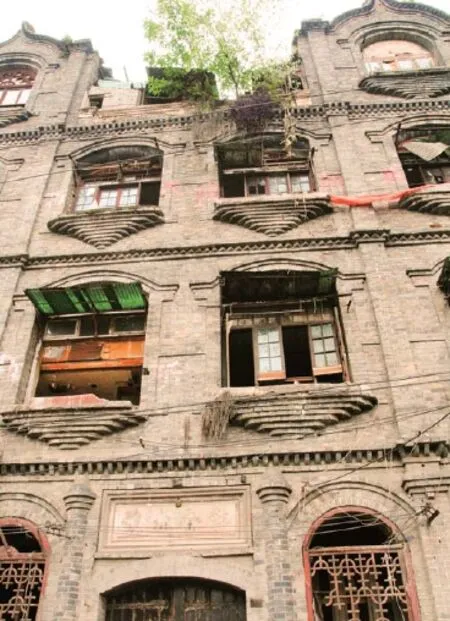
江全泰号被烧前的旧貌。(图片由重庆文物保护志愿者服务队提供)
这栋建筑原本造型别致,曾是白象街的建筑标杆,附近大多房屋在当年就受其风格的影响而建。它由层层叠叠的青石砖砌筑成,窗台呈倒置的“金字塔”,像一盏盏火焰。敦实的墙身、拱形的天花穹顶、窗棂上鳞形浮雕,是典型的巴洛克建筑风格与中国传统建筑风格相融的建筑精品。2008年,江全泰号被列入重庆市优秀近现代建筑名录,2009年12月被公布为重庆市文物保护单位。
在这栋楼的历史背后,有一位改写过重庆历史的重要人物—重庆民营企业家卢作孚先生。重庆开埠后,西方列强一直控制着海关,掌握重庆航权,大大遏制了中国本土民营经济。1925年,卢作孚先生创办了民生公司,在川江上与洋人进行竞争。1935年,他成功收购美国大来公司7艘外国轮船,由此助长了中华民族之士气。同年,美国的大来公司倒闭,江全泰号就辗转归入爱国实业家卢作孚名下,后成为居民居住区。现在这栋饱经岁月侵蚀的老建筑,正在期待着重焕新生,重庆人都十分期待。
望龙门缆车旧址:拥有中国第一条客运缆车
位于白象街旁的望龙门缆车在老重庆人心里留有深刻的印记。消失已久的望龙门缆车,现在被纳入下半城历史文化街区的保护范围。重庆人将有机会再次乘坐缆车。据了解,缆车车厢将被原样复制后成为移动的小型陈列馆,里面将陈列当年的历史资料和老照片。修复后的缆车将成为下半城历史街区的游览景观,同时延续它的重要使命,继续解决下半城的交通问题,缆车两旁还将设立步道供旅游休闲之用。
上世纪40年代,重庆望龙门因地形高低不平,与长江码头落差大,这才修建了一种特别的交通工具—望龙门缆车,这是中国第一条客运缆车,它穿行于江边和山腰,靠着缆绳上下,曾一度是重庆人最主要的出行工具,解决了当地人爬坡费时费力的出行问题。
望龙门缆车全长178米,上下高差有近47米。停车站设在江边,供当地人候车使用,缆车道在原来步行的码头石阶上修建了钢筋混凝土栈桥,桥上铺设了轨道,车箱就在轨道上上下滑行。缆车轨道呈“鱼腹式”,中间是双车道,两边是单车道,两个缆车在中间分道行驶。缆车通车是当年轰动重庆的大事,一时万人空巷,很多重庆市民都赶去乘坐缆车。当年每隔8分钟发趟车,高峰期发车时间更短,不输于今天快节奏的轻轨发车的节奏。缆车车厢一次可载50人,下行的票价比上行更便宜。望龙门缆车的车厢像一个巨大的面包车,车头有一座山的标志,没有可以关闭的门,乘客可以在门边探出头,“打望”外面的风景。
缆车所在的江边一带曾非常繁荣,每天接待从江对岸坐船过来的人。夏季江边涨水,缆车就停运。直到后来修建了重庆长江索道,越来越少的人乘坐望龙门码头到龙门浩的过江轮渡,望龙门缆车因此也少了不少乘客。幸运的是,在不久的将来,我们还能再见缆车当年的风采。相信在恢复通车之时,又将是一场盛事。
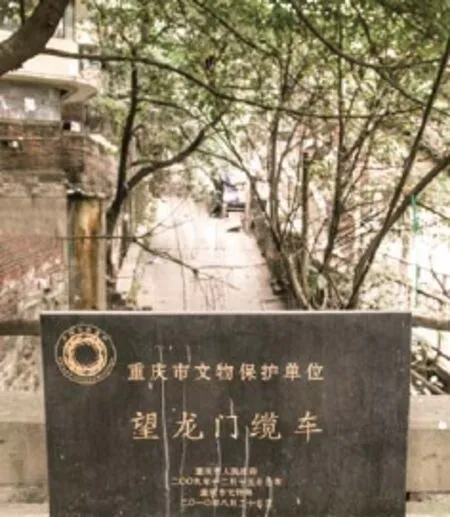
这些还只是文化遗迹的一部分,光在下半城,能代表重庆历史文化的文物建筑就有很多,其背后的故事更是说不完。今天的白象街随着时间的积累逐渐酝酿出一种独特的老重庆气质,它就像一面镜子,折射出了一个时代的荣光。据统计,下半城是外地游客必游重庆的热门景点,目前与解放碑咫尺之隔的白象街,以不可替代的历史与人文沉淀,拓展了解放碑商圈旅游的丰富性。
北京有老胡同,上海有石库门,重庆有一条白象街,它以城市核心、历史传承、商业改造这三大亮点打造,虽深处闹市却又从容平静,它随同这个这座城市发展的脉搏,不再被遗弃在沉寂的岁月里。蛰伏半个多世纪后,它正在原址慢慢“复活”,新的故事将在这里继续延续,历史文化将在这里继续传承。
Based on history and talk about the old streets in those years
Baixiang Street was once the economic center in Chongqing since Chongqing’s opening-up in 1891.This tiny place,which was the earliest to own the wired telegraph of fice,medicine association,Bureau of Post of Qing Dynasty,and American Dollar Company in Chongqing,had attracted China’s and even the world’s attention,and was called as the“f nancial street”.Just like the W all Street in New York,celebrities came to this place in an endless stream from countries,like the UK,US and Japan had set up foreign f rms to make a packet.
In March,a season of natural recovery,the reporter,as a seeker,walks along the fresh new Baixiang Street.Decorated with the steel grey brick walls,European-style doors and windows,and the wooden eaves,the simple architectural style of Republic can be easily noticed.Besides,immersing in the ancient and lingering dense atmosphere,your nostalgic mood will spread due to the confusion of time and space.
Running through the W anglongmen and Taipingmen,Baixiang Street (“Baixiang”means the white elephant) got its name from a legend.It is said that long long ago,there was a white-marble sculpture of stone elephant on the street.Therefore,a new sculpture of stone elephant can be seen on the street,which is exactly opposite to the pair of bluestone lions in the Xuantan Temple in Nan’an District.People said,“The bluestone lions and the white-marble elephants lock the big river together.”
In recent years,Chongqing municipal government constantly increases the efforts of excavation,protection,utilization and inheritance of historical relics in the mother town,and exploits and constructs the historical and cultural blocks,in order to inherit the historical context and promote the Bayu Culture.Baixiang Street,as one part of the restoration project of the historical and cultural blocks in the down area,turns into a new chapter in city construction.Given the city’s function and new features in the new era,relying on the opening-up concept of Chongqing,Baixiang Street will be programmed under the concept of“development through protection and protection through development”.In order to maintain the original appearance of several cultural relic buildings,the planning tool of“protection,darning,acupuncture and suture”will be adopted.A comprehensive region,consisting of culture,history,tourism and commerce,is now in its resurrection.
Those architectures are not only the container carrying Chongqing people’s memory,but also paint a new picture and became the city’s card and“new living room”for Chongqing to meet the world.Celebrities and politicians like the French President Nicolas Hollande,Neil Bush,the president of the US,and his family had been received here.
At present,some old architectures are still under repair.When those architectures come back to people’s vision,the encounter of the“old”and“new”will express a different kind of delicacy and elegance.
The new Baixiang Street will evoke people’s memory of the old city and deepen young people’s interpretation of this city.Those historical relics and each old building that scattered on Baixiang Street all boast a memorable past.Today,following reporter’s footsteps,let’s explore the stories behind them then!
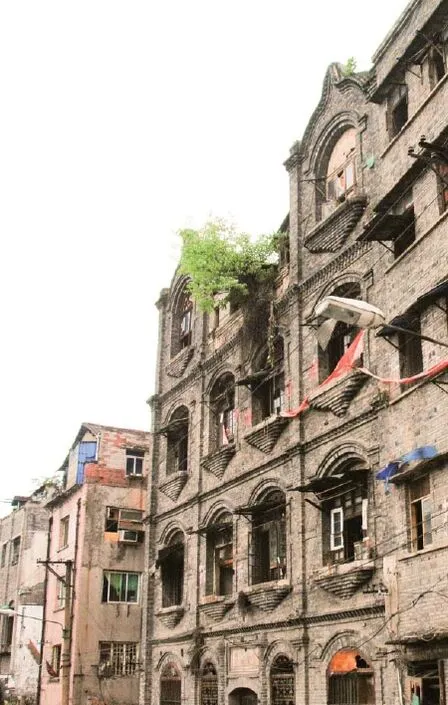
The gray brick wall carries the history and old stories of Baixiang Street.(Pictures are provided by Chongqing heritage conservation volunteers group.)
The former site of medicine association: It witnessed the glorious history of Chongqing’s medicine industry
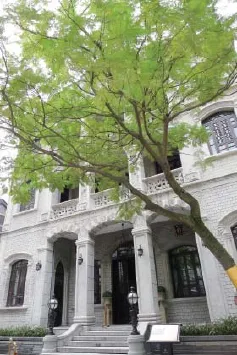
It is easy for the reporter to f nd the former site of medicine association in the street,which is still decent after the reconstruction on the same place.The bead tree,with luxuriant foliage,still stands before the foreign-style 3-storey building.It is said that the tree was then planted by the frst president of medicine association.A large fountain is newly built in the center of the garden.On the top of the architecture,there are three doorways 5 meters high,which represent the typical baroque style.The medicine association,once mastering the lifeline of medicine sales in Chongqing,now becomes a gathering place of culture and art,attracting a lot of intellectuals and artists.On March 5,the French Sophia Art Foundation held a painting exhibition of contemporary female artists here,in which more than 50 paintings were shown.Once the old architecture met the art,it would show its elegance and luxury with a brand new look.
Medicine association in Chongqing enjoyed a pivotal position whose history can be traced back to the end of Ming Dynasty and the early Qing Dynasty.The Yangtze River and Jialing River met at Yuzhong District,which gave birth to the prevailing of waterways.Lin’an Confraternity of Jiangxi Province became the frst to set the confraternity of medicine firm in Baixiang Street,followed by the confraternities of Zhejiang Province,and Guangdong Province,for which Baixiang Street not only became the transfer station connecting Hubei,Hu’nan,Jiangxi and Guangdong to each province in southwest China,and also the then most busy medicine market in the nationwide in a short time.
According to the records of Chongqing Customs Department,if we make a rank of the exports in Chongqing from 1930 to 1939,the top three were mountain products,tung oil and medicine.The merchants and shops stood in great numbers around the medicine market.At that time,due to the increase of shops,the competition in this industry became f ercer than ever,so was the contradiction between the local Yaoqi Confraternity and Shisan Confraternity from other provinces.In order to achieve a win-win situation,the Medicine Association of Chongqing was established after the several negotiations among those medicine confraternities in June,1926.Hence,this foreign-style building was built on Baixiang Street,i.e.the former site of Medicine Association.Once upon a time,many people coming and going at this place were influential figures in the Chinese pharmaceutical industry,and many important decisions affecting the medicine market were negotiated and determined here.
Time flies and the once bustling pier is now silent over those years.Until now,there are still many medicine shops near the medicine market.So every time when we pass by the market,the strong smell of medicine could still be smelt.And when the former site of medicine association“wakes up”in the modern intense tension,the collision between the lingering charm of century-old architecture and the modern art and culture has played a time-crossing symphony together.
Li Yaoting’s Mansion: The frst electric light in Chongqing was lit up here
Looking to the large construction site on the riverside from afar,several buildings are wrapped by the high scaf folding and the green fence.The work sheds are built in lines and builders are busy around on site.A small building stands out clearly against a f at ground.Sizing up its outline,the reporter immediately identified it as Bufengju,i.e.the Mansion of Li Yaoting,the richest man in the southwest China.
Through the green fence,the wooden window lattice embedded in the bluestone wall can be seen clearly,and“Bufengju”is written on the bluestone door.In accordance with the historical records Yuzhong Financial History,born in a poor family,Li Yaoting first traveled between Yunnan and Sichuan,selling tea,crude opium and salt to each place.He later ran the exchange shop of Chongqing branch of Tianshunxiang.In the beginning of the 20th century,Tianchunxiang had openedseveral branches in the nationwide and established institutions in Hongkong,China and Haiphong,V ietnam and etc.It dominated the industry in Chongqing.Li Yaoting had also gradually set up Shunchang Company,Xinji Bank and many industrial corporations in making electric lights,silk,ships and so on.His fame spred far and wide.
Although Bufengju faces the north and the Yangtze River,the modern buildings located on the riverside block the view.Otherwise,this mansion must be a good place to overlook the river view.The whole mansion in a circular arc,is shaped like a boat.But if you take a far view,it is just like a blockhouse with its brick,wood and grey tile.Three stories in the front and four storiess in the back,this well-proportioned building combines the Chinese and Western architectural style,which is quite common in the period of opening-up.
Once there was a flash-news happened in this building.The first electric light in Chongqing was lit up right in this building which had become a sensational novelty.In 1906,when Liu Peigao,the gentle merchant in Baxian County,installed the 100KW DC generator at Taipingmen,it was the first time to supply power externally.That day was Li’s 70th birthday,and 50 electric lights in Bufengju were lit up together in that night,which had shocked the whole of Chongqing and become the topic focus at people’s leisure.
A f re occurred in the Li Yaoting’s mansion in 2005,damaged some part of the building.The reporter learned that this old building will be repaired in the light with its original appearance,and it is expected to complete the restoration at the end of 2017 from the“Approval of the Restoration and Design Plan of the Former Site of Li Yaoting’s Mansion”.As for how to utilize this building,it is not to be determined yet.
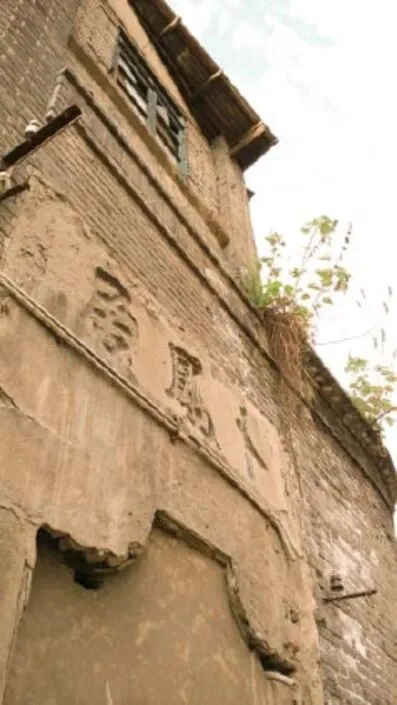
The Jiangquantai: The key to regain the Chuanjiang River Route
The old foreign-style four-story building,standing on the riverside of Baixiang Street,was also damaged in the fire in October,2015,which is exactly the Jiangquantai,i.e.the former site of American Dollar Company.The reporter learned from the Chongqing Bureau of Cultural Relics that the relevant government agencies would repair this municipal cultural protection building in accordance with its original appearance.
Since this building was once a landmark of Baixiang Street with its original unique shape,most of the houses nearby were built under the impact of its style.Consisting of many layers of bluestone bricks,the windows of this building are like many f ames in the shape of inverted“Pyramid”.With the solid walls,vaulted ceiling dome and the squama-shaped emboss on the window lattice,this building is a typical architecture blending the baroque architectural style and traditional Chinese architectural style.In 2008,the Jiangquantai was on the list of Chongqing Excellent Modern Architectures and announced as the Chongqing municipal cultural relics protection units in December,2009.
Behind the history of this building,there was a man named Lu Zuofu,a private entrepreneur in Chongqing who had rewritten the history of Chongqing.After the opening-up of Chongqing,Mr.Lu founded the Minsheng Company,competing with the foreigners on the Chuanjiang River.In 1935,he successfully acquired 7 foreign boats of Dollar Company,which had encouraged the morale of the Chinese nation.In the same year,along with the collapse of American Dollar Company,the Jiangquantai was included into the patriotic industrialist Lu Zuofu’s property,and then became the residential areas.Nowadays,this building after those years of erosion is waiting for a new lease of life and even the Chongqing people are looking forward to it.
The former site of Wanglongmen cable car China’s frst passenger transportation cable car
The Wanglongmen cable car,located near the Baixiang Street,must have left a deep imprint in the hearts of the elder Chongqing people.The long-lost Wanglongmen cable car is now included into the down area’s protection of historical and cultural streets.Therefore,Chongqing people will have the opportunity to take a cable car again.It is understood that the cable car would be copied as a small moving exhibition hall where the historical information and old pictures would be displayed.After restoration,the cable car will become a tourist spot in the down area’s historical and cultural streets,while continues its important mission to solve the traf fic problems in the down area.The walkways will also be set up on the both sides of the cable car for tourism and leisure.
In the 1980s,a special traf fic tool,Wanglongmen cable car,was built due to the uneven terrain and the big drop between Wanglongmen and the pier,which is China’s first passenger transportation cable car.Running through the riverside and the mountainside,and relying on the cable to go down and move up,the cable car was once the main means of transportation for Chongqing people,which had solved the traff c issues of timeconsuming climbing for the local people.
The Wanglongmen cable car is 178 meters in length and the height dif ference nearly 47 meters.The parking station is located on the riverside for the local people to wait the cable car.The reinforced concrete trestle is built over the original walkways on the pier stone steps,on which the cable railways are installed.The cable is able to glide up and down on the track.With two lanes in the middle and single lanes on both sides,the cable railways show“f shbellied”and two cable cars move on its own track.The operation of the cable car was a sensational event in Chongqing at that time,therefore many Chongqing people rushed to take the cable car.The cable car would departure at 8-minute intervals and even shorter in the rush hour,which was no less than the departure frequency of fast-paced light rail at present.The cable car could carry 50 people at a time and cost less to go down.The cabin of the Wanglongmen cable car was just like a giant minibus with a mountain mark on the front.As there was no doors that could be closed in the cabin,passengers could poke their heads out of the door to catch the view outside.
The riverside used to be very prosperous for receiving people from the other side of the river.Once the river rose in summer,the cable car would stop the service.After the construction of Chongqing Yangtze River Cableway,since fewer and fewer people chose to take a ferry from the Wanglongmen Pier to Longmenhao,there were even less passengers who would take the W anglongmen cable car.However,we are able to get a glimpse of it in the near future.There is no doubt that the reopening of the cable car would be a great event again.
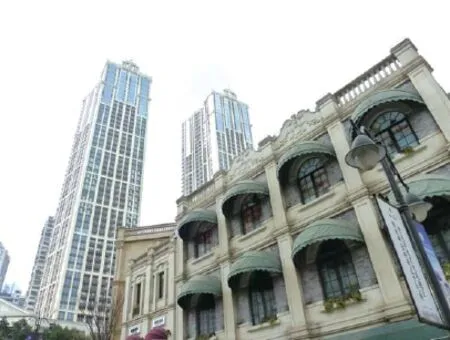
These are only one part of the cultural relics and in the down area only since there are a lot of historic buildings that could represent the history and culture of Chongqing.The stories behind them would be endless.With the passing of time,Baixiang Street gradually brews a unique quality belonging to the old Chongqing,which turns into a mirror,ref ecting the glory of an era.According to the statistics,scenic spots in the down area are popular among the non-native tourists.Baixiang Street,steps away from the Jiefangbei,has expanded the richness of Jiefangbei Business District with its irreplaceable history and culture.
Just like Hutong in Beijing,Shikumen in Shanghai,Baixiang Street in Chongqing,which is built with such features of the urban core,historical heritage and business transformation,owns its easiness and quiet atmosphere in the downtown.With the development of this city,it would no longer be abandoned in the dreary years,sleeping for over half a century .Moreover,it is now reviving on its original site where new stories will continue to go on and the traditional culture will continue to be inherited.
Feel the Old Architectural Culture and Seek the Old Story of Baixiang Street
□Article,Pictures Journalist Yang Yan

